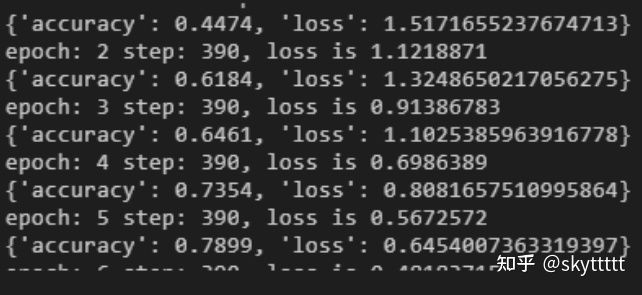1 模型测试在训练完成之后,需要测试模型在测试集上的表现。依据模型评估方式的不同,分以下两种情况1.评估方式在MindSpore中已实现MindSpore中提供了多种Metrics方式:Accuracy、Precision、Recall、F1、TopKCategoricalAccuracy、Top1CategoricalAccuracy、Top5CategoricalAccuracy、MSE、MAE、Loss 。在测试中调用MindSpore已有的评估函数,需要定义一个dict,包含要使用的评估方式,并在定义model时传入,后续调用model.eval()会返回一个dict,内容即为metrics的指标和结果。...def test_net(network, model, test_data_path, test_batch):"""define the evaluation method"""print("============== Start Testing ==============")# load the saved model for evaluationparam_dict = load_checkpoint("./train_resnet_cifar10-1_390.ckpt")#load parameter to the networkload_param_into_net(network, param_dict)#load testing datasetds_test = create_dataset(test_data_path, do_train=False,batch_size=test_batch)acc = model.eval(ds_test, dataset_sink_mode=False)print("============== test result:{} ==============".format(acc))if name == "__main__":...net = resnet()loss = nn.loss.SoftmaxCrossEntropyWithLogits(sparse=True,reduction='mean')opt = nn.SGD(net.trainable_params(), LR_ORI, MOMENTUM_ORI, WEIGHT_DECAY)metrics = {'accuracy': nn.Accuracy(),'loss': nn.Loss()}model = Model(net, loss, opt, metrics=metrics)test_net(net, model_constructed, TEST_PATH, TEST_BATCH_SIZE)2.评估方式在MindSpore中没有实现如果MindSpore中的评估函数不能满足要求,可参考accuracy.py 通过继承Metric基类完成Metric定义之后,并重写clear,updata,eval三个方法即可。通过调用model.predict()接口,得到网络输出后,按照自定义评估标准计算结果。下面以计算测试集精度为例,实现自定义Metrics:class AccuracyV2(EvaluationBase):
def __init__(self, eval_type='classification'):
super(AccuracyV2, self).__init__(eval_type)
self.clear()
def clear(self):
"""Clears the internal evaluation result."""
self._correct_num = 0
self._total_num = 0
def update(self, output_y, label_input):
y_pred = self._convert_data(output_y)
y = self._convert_data(label_input)
indices = y_pred.argmax(axis=1)
results = (np.equal(indices, y) * 1).reshape(-1)
self._correct_num += results.sum()
self._total_num += label_input.shape[0]
def eval(self):
if self._total_num == 0:
raise RuntimeError('Accuary can not be calculated')
return self._correct_num / self._total_num
def test_net(network, model, test_data_path, test_batch):
"""define the evaluation method"""
print("============== Start Testing ==============")# Load the saved model for evaluation
param_dict = load_checkpoint("./train_resnet_cifar10-1_390.ckpt")# Load parameter to the network
load_param_into_net(network, param_dict)# Load testing dataset
ds_test = create_dataset(test_data_path, do_train=False,
batch_size=test_batch)
metric = AccuracyV2()
metric.clear()
for data, label in ds_test.create_tuple_iterator():
output = model.predict(data)
metric.update(output, label)
results = metric.eval()
print("============== New Metric:{} ==============".format(results))
if __name__ == "__main__":...
net = resnet()
loss = nn.loss.SoftmaxCrossEntropyWithLogits(sparse=True,
reduction='mean')
opt = nn.SGD(net.trainable_params(), LR_ORI, MOMENTUM_ORI, WEIGHT_DECAY)
model_constructed = Model(net, loss, opt)
test_net(net, model_constructed, TEST_PATH, TEST_BATCH_SIZE)2 边训练边验证在训练的过程中,在验证集上测试模型的效果。目前MindSpore有两种方式。1、交替调用model.train()和model.eval() ,实现边训练边验证。...def train_and_val(model, dataset_train, dataset_val, steps_per_train,
epoch_max, evaluation_interval):
config_ck = CheckpointConfig(save_checkpoint_steps=steps_per_train,
keep_checkpoint_max=epoch_max)
ckpoint_cb = ModelCheckpoint(prefix="train_resnet_cifar10",
directory="./", config=config_ck)
model.train(evaluation_interval, dataset_train,
callbacks=[ckpoint_cb, LossMonitor()], dataset_sink_mode=True)
acc = model.eval(dataset_val, dataset_sink_mode=False)
print("============== Evaluation:{} ==============".format(acc))if name == "__main__":
...
ds_train, steps_per_epoch_train = create_dataset(TRAIN_PATH,
do_train=True, batch_size=TRAIN_BATCH_SIZE, repeat_num=1)
ds_val, steps_per_epoch_val = create_dataset(VAL_PATH, do_train=False,
batch_size=VAL_BATCH_SIZE, repeat_num=1)
net = resnet()
loss = nn.loss.SoftmaxCrossEntropyWithLogits(sparse=True,
reduction='mean')
opt = nn.SGD(net.trainable_params(), LR_ORI, MOMENTUM_ORI, WEIGHT_DECAY)
metrics = {
'accuracy': nn.Accuracy(),
'loss': nn.Loss()
}
net = Model(net, loss, opt, metrics=metrics)for i in range(int(EPOCH_MAX / EVAL_INTERVAL)):
train_and_val(net, ds_train, ds_val, steps_per_epoch_train,
EPOCH_MAX, EVAL_INTERVAL)
2、MindSpore通过调用model.train接口,在callbacks中传入自定义的EvalCallBack实例,进行训练并验证。
class EvalCallBack(Callback):
def __init__(self, model, eval_dataset, eval_epoch, result_evaluation):
self.model = model
self.eval_dataset = eval_dataset
self.eval_epoch = eval_epoch
self.result_evaluation = result_evaluation
def epoch_end(self, run_context):
cb_param = run_context.original_args()
cur_epoch = cb_param.cur_epoch_num
if cur_epoch % self.eval_epoch == 0:
acc = self.model.eval(self.eval_dataset, dataset_sink_mode=False)
self.result_evaluation["epoch"].append(cur_epoch)
self.result_evaluation["acc"].append(acc["accuracy"])
self.result_evaluation["loss"].append(acc["loss"])
print(acc)
if name == "__main__":
...
ds_train, steps_per_epoch_train = create_dataset(TRAIN_PATH,
do_train=True, batch_size=TRAIN_BATCH_SIZE, repeat_num=REPEAT_SIZE)
ds_val, steps_per_epoch_val = create_dataset(VAL_PATH, do_train=False,
batch_size=VAL_BATCH_SIZE, repeat_num=REPEAT_SIZE)
net = resnet()
loss = nn.loss.SoftmaxCrossEntropyWithLogits(sparse=True,
reduction='mean')
opt = nn.SGD(net.trainable_params(), LR_ORI, MOMENTUM_ORI, WEIGHT_DECAY)
metrics = {
'accuracy': nn.Accuracy(),
'loss': nn.Loss()
}
net = Model(net, loss, opt, metrics=metrics)result_eval = {"epoch": [], "acc": [], "loss": []}
eval_cb = EvalCallBack(net, ds_val, EVAL_PER_EPOCH, result_eval)
net.train(EPOCH_MAX, ds_train,
callbacks=[ckpoint_cb, LossMonitor(), eval_cb],
dataset_sink_mode=True, sink_size=steps_per_epoch_train)3 样例代码使用说明本文的样例代码是一个Resnet50在Cifar10上训练的分类网络,采用datasets.Cifar10Dataset接口读取二进制版本的CIFAR-10数据集,因此下载CIFAR-10 binary version (suitable for C programs),并在代码中配置好数据路径。启动命令:python xxx.py --data_path=xxx --epoch_num=xxx运行脚本,可以看到网络输出结果: